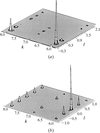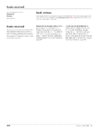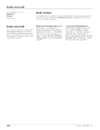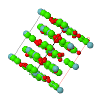issue contents
June 2001 issue

Cover illustration: The structure of Pu31Pt20 [D. T. Cromer & A. C. Larson (1977). Acta Cryst. B33, 2620-2627] viewed nearly perpendicular to a Pu, Pt disc (10 Å thick and 50 Å in diameter) down [111]. Details of the structure were taken from the intermetallics crystal structure database CRYSTMET® using the Materials ToolKit graphics software from Toth Information Systems, Inc.
research papers
Download citation


Download citation


The twinned low-temperature monoclinic (P1121) structure of K2Mn2(BeF4)3 has been determined. Unlike the known structures of langbeinite, the low-temperature unit cell is doubled along the crystallographic b axis with respect to the parent phase. In the monoclinic phase the BeF4 tetrahedra occupying the same position in the cubic phase along two consecutive unit cells rotate differently.
Download citation


Download citation


The low-temperature 2c0 superstructure of Cs2HgCl4 has been determined by X-ray scattering. The comparison of the parent structure with the 2c0, 3c0 and 5a0 superstructures shows that the phase transitions are driven towards increased bonding of the underbonded Cs(1)-type atoms.
Download citation


Download citation


The φ-Bi8Pb5O17 triclinic structure, recently solved by the synergic use of electron and powder X-ray diffraction, has been refined on neutron diffraction data. The occurrence of cationic ordering, indicated by valence bond and charge distribution analysis, has been confirmed by site occupancy refinements. The structure was found to be ordered to a large extent, with Bi and Pb atoms occupying preferentially different lattice sites.
Download citation


Download citation


The crystal structure and the electron density in β-NaxV2O5 [x = 0.282 (3)] have been studied at 9.6 K.
A Euclidean dissimilarity index, Rc(x), based on L—M—L valence angles is defined which permits the intercomparison and mapping of the coordination sphere geometries of MLn species in crystal structures of metal complexes. Taking account of atomic permutational symmetry, the technique identifies clusters of observations that represent geometrical preferences and local distortions, together with pathways that map geometrical interconversions of coordination sphere geometries.
An investigation of 135 π-complexes of rare-earth atoms was carried out with Voronoi–Dirichlet polyhedra. A novel method for the evaluation of the sizes of polyatomic ligands and steric effects in the structure of organometallic compounds was developed.
Download citation


Download citation


The structure of the commensurate phase of Ca2CoSi2O7 has been derived from the modulated structure described in (3 + 2)-dimensional space and refined by a least-squares method in three-dimensional space. The structure is composed of twins of orthorhombic individuals.
Detailed studies on the significance of higher coordination shells and a novel empirical correlation of the bond-valence parameter b to the softness of a bond permit the systematic determination of softness-sensitive bond-valence parameters.
Download citation


Download citation


The crystal structures of [Cu(NO3)2(pm)2]n (pm = pyrimidine), [Cu(NO3)2(H2O)2(pm)]n and Cu(NO3)2(H2O)2(pm)2 were determined and relations between chain structures and magnetic interactions were discussed.
Download citation


Download citation


The structures of the Pnma and P212121 phases of 38% brominated betaine (trimethylammonioacetate) calcium chloride dihydrate have been determined by single-crystal neutron diffraction at 295 and 20 K, respectively. The distortion with respect to the high-temperature Pnma phase is characterized by anti-symmetric displacements of the betaine molecules as well as of the Ca octahedra. The direct phase transition that occurs around 80 K between these two phases is interpreted in the scope of a symmetry-mode analysis.
Download citation


Download citation


The self-assembly of cobalt(II) and nickel(II) octahedra formed by cupferronato and neutral N-donor ligands and their NH2 functions leads to extended two-dimensional hexagonal and pseudo-hexagonal grid-type networks. The solvent molecules play a key role in such systems.
Download citation


Download citation


The very short hydrogen bonds in potassium hydrogen dichloromaleate have been studied by neutron diffraction at 30 and 295 K. The hydrogen bonds are asymmetric, although the environment is centrosymmetric.
Download citation


Download citation


The title anion forms finite molecular aggregates with Li+ and Mn2+, simple aquated salts with Mg2+ and Zn2+, but organic–inorganic hybrid sheets with Na+ and K+.
Download citation


Download citation


3,5-Dihydroxybenzoic acid forms hydrated salt-type adducts with a range of organic diamines. The molecular components are linked by an extensive series of N—H⋯O, O—H⋯O and O—H⋯N hydrogen bonds into continuous arrays in two or three dimensions.
Download citation


Download citation


The structure of the crown ether P326, the parent compound for a series of derivatives, is presented as determined by room-temperature X-ray diffraction and low-temperature neutron diffraction. Forming a very useful pedagogical example, a variety of situations arose through the two simultaneous and interdependent data collections and analyses, complicated by an extremely unusual combination of lattice geometry and pseudosymmetry.
Download citation


Download citation


The thermal evolution of the lattice parameters, expansion tensor coefficients, and rigid-body translation and libration tensors, as well as the torsional vibration of the nitro group, were studied in order to understand the molecular interactions and dynamics leading to thermodynamic transitions.
Download citation


Download citation


The crystal formed by urea and phosphoric acid is stabilized by hydrogen bonds, including the very short d(O⋯O) = 2.410 (2) Å. Deformation maps obtained from multipole refinements show the hydrogen bonding effect on P—O bonds and the covalent character of the two O—H interactions of the short hydrogen bond.
Download citation


Download citation


The electron density and related properties of the quasi-stable β form of 5-nitro-2,4-dihydro-3H-1,2,4-triazol-3-one (NTO; space group P21/c) have been determined from low-temperature X-ray diffraction.
Download citation


Download citation


The complexes exhibit novel patterns of amino acid aggregation. They also illustrate the profound effect reversal of chirality can have on aggregation.
Download citation


Download citation


The crystal structures of β-1,2,3-tritetradecanoylglycerol (β-trimyristin or β-MMM) and β-1,2,3-trioctadecanoylglycerol (β-tristearin or β-SSS) have been determined from high-resolution synchrotron X-ray powder diffraction data using grid-search techniques and refined with Rietveld refinement to final Rp values of 0.053 and 0.041, respectively.
Download citation


Download citation


The structure of the composite crystal urea/n-octane has been solved using the superspace formalism [superspace group P6122(00γ) 0
0![]](/b/issues/2001/03/00/na0114/teximages/na0114fi2.gif) . A comparison of the proposed model with that of the urea/heptadecane crystal shows that the modulation of n-alkane molecules is provoked by the shape of the urea tunnels.
. A comparison of the proposed model with that of the urea/heptadecane crystal shows that the modulation of n-alkane molecules is provoked by the shape of the urea tunnels.
Download citation


Download citation


The average structure of the composite crystal urea/octanedioic (suberic) acid has been solved using the superspace formalism under the superspace group H′3121(00γ)00 . The strong orientational disorder shown by the guest molecules has been modelled using 12 equiprobable orientations of suberic acid molecules within the urea tunnels.
. The strong orientational disorder shown by the guest molecules has been modelled using 12 equiprobable orientations of suberic acid molecules within the urea tunnels.
Download citation


Download citation


The structures of binaphthol with picoline isomers have been elucidated. The lattice energies are correlated with their thermal stabilities, selectivities and activation energies of desolvation.
Download citation


Download citation


Weak but numerous host–guest interactions and induced fit of the hosts are responsible for the observed enantioselectivity. The difference of the hosts to selectively bind one of the optical antipodes is reflected in very subtle differences in the C—H⋯O intermolecular distances between host and guest.
Download citation


Download citation


4-Nitro-4′-methylbenzylidene aniline (NMBA) was studied by neutron diffraction in order to rationalize its large second-harmonic generation output via its structural characteristics: C—H⋯X hydrogen bonding and very close interplanar separations are shown to be important supramolecular features in this regard.
Download citation


Download citation


The results presented demonstrate the importance of dipole/dipole interactions between CO and βC*H groups in stabilizing the molecular conformation, and between carbonyl groups in stabilizing crystal packing of molecules that lack classical hydrogen-bond donor groups. An illustration is provided as to how a small change in mutual orientation of molecules arranged in a close-packed fashion causes a change in the character of intermolecular interactions from van der Waals to sandwich stacking and to dipolar. Hydrogen bonds with ester carbonyls as acceptors are formed by the amide but not by carboxyl donor groups.
Download citation


Download citation


Some thiocyanurates undergo intermolecular methyl rearrangement in the solid state. The crystal structures and DSC thermographs of representatives of thiocyanurates are described and discussed. It is shown that this type of reaction in the solid state is topochemically controlled.
Download citation


Download citation


The position of the H atom in the strong O—H⋯O hydrogen bond in urea–phosphoric acid is monitored by neutron diffraction using a multiple single crystal sample. The proton position is found to change significantly as a function of temperature, migrating along the hydrogen bond to become more centred as the temperature increases.
books received
Free 

Free 



 journal menu
journal menu















































